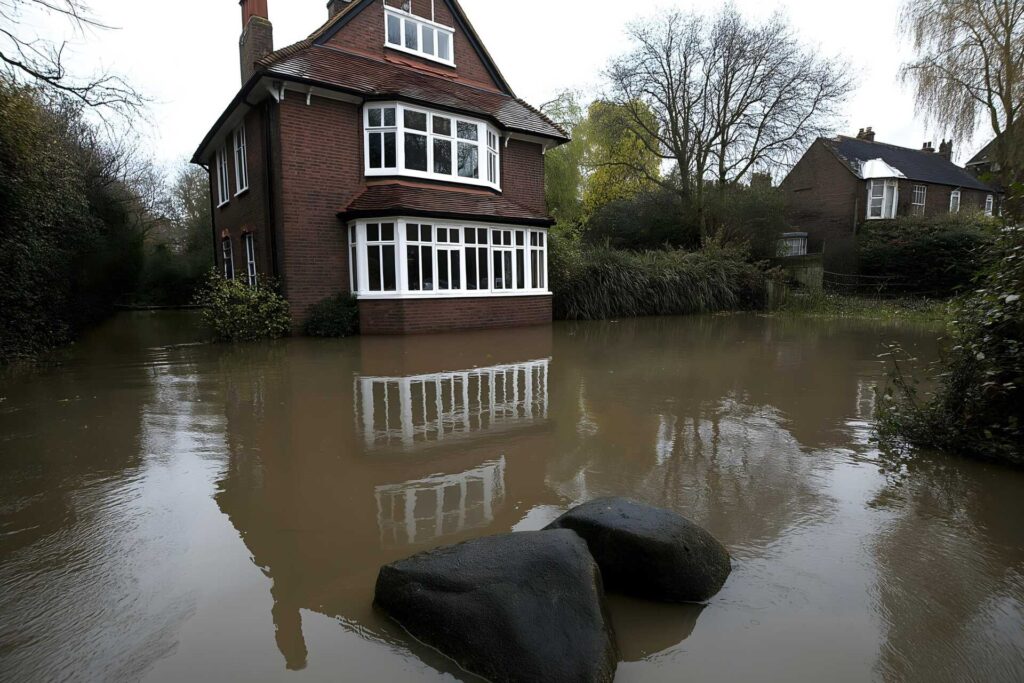
Contents
When faced with a flooded home, the aftermath can feel overwhelming and chaotic. A structured approach to Flooded Home Recovery is essential to ensure no critical steps are missed. By assessing the damage early and prioritizing safety, you lay the groundwork for a successful restoration. Every decision you make impacts your home and your well-being. Learn how to navigate this process efficiently and protect your home for the future.
Key Takeaways
- Assess visible and hidden damage thoroughly, documenting everything with photos and notes for insurance claims.
- Ensure safety by wearing protective gear and checking for hazards like downed power lines before entering the property.
- Start water extraction promptly using pumps or wet vacuums to minimize further damage and prevent mold growth.
- Clean and disinfect affected areas with proper supplies to eliminate contaminants and prevent future health risks.
- Implement waterproofing measures and maintain drainage solutions to protect your home from future flooding.
Assess the Damage Immediately
As soon as it’s safe to enter your home, evaluating the damage immediately is essential for your recovery process.
Start with a thorough damage evaluation, focusing on both visible and hidden issues. Check walls, floors, and ceilings for signs of water intrusion or mold growth, as these can compromise your home’s structural integrity. Look for warped wood, peeling paint, or rust on metal fixtures—each detail matters.
Document everything with photos and notes; this will help you understand the repairs needed and assist with insurance claims.
Remember, you’re not alone in this journey. Many have faced similar challenges, and sharing your experience can foster a sense of belonging within your community.
As you assess, stay connected with friends or local support groups who can lend a helping hand or offer advice. Your home is more than just bricks; it’s a sanctuary that deserves to be restored.
Prioritize Safety and Health
Prioritizing safety and health is essential after a flood, especially since lingering water and dampness can create hazardous conditions.
Start by verifying your immediate environment is safe. Check for downed power lines and avoid entering flooded areas where there may be unseen dangers. Keep your emergency contacts handy—having access to local health services and disaster response teams can be invaluable.
Health precautions are critical; mold growth can begin within 24-48 hours.
Wear protective gear like gloves and masks when handling contaminated materials. Verify proper ventilation in your home to combat moisture and prevent respiratory issues.
If you feel unwell or notice unusual symptoms, reach out to a healthcare professional promptly.
Document Everything for Insurance
After ensuring your safety and addressing health concerns, the next step is to document everything for insurance purposes.
Start by taking clear, detailed photos of the damage in your home, capturing each room and affected item. This visual evidence is essential for your insurance claim. Don’t forget to write down descriptions and any relevant dates.
Compile a list of damaged items, including their original purchase price and estimated replacement costs. This thorough documentation process can greatly speed up your claim and ensure you receive fair compensation.
If you’ve got receipts or warranties, gather those too. They strengthen your case and help validate your claim.
Start Water Extraction as Soon as Possible
Starting water extraction within the first 24 to 48 hours is essential to minimizing damage and preventing mold growth in your flooded home. The longer you wait, the more severe the consequences can be.
Begin with effective water removal methods like pumps or wet vacuums, which can swiftly eliminate standing water. These tools are vital for addressing the immediate threat and can make a significant difference in your recovery process.
As you start, consider reaching out to professionals who specialize in extraction methods; they possess the expertise and equipment to handle extensive damage.
It’s also important to prioritize your safety during this process. Wear protective gear and avoid electrical hazards.
Dry Out Your Home Thoroughly
Once you’ve removed standing water, it’s vital to dry out your home thoroughly to prevent further damage and mold growth.
Start by using a dehumidifier; it’ll help extract moisture from the air, speeding up the drying process. Ideally, run it continuously for several days, monitoring the water levels regularly.
Next, implement effective ventilation techniques. Open windows and doors to create airflow, allowing fresh air to circulate. If the weather permits, use fans to direct air towards damp areas, enhancing evaporation.
Remember, a well-ventilated space is important for drying, so consider using exhaust fans in bathrooms and kitchens.
Check hidden spaces like under cabinets and behind walls, as moisture can linger unnoticed.
Clean and Sanitize Affected Areas
After your home is thoroughly dried, it’s essential to assess the extent of the damage to understand what needs cleaning and sanitizing.
Use the right cleaning supplies to effectively eliminate contaminants and prevent mold growth, ensuring your space is safe for you and your family.
Taking these steps restores your home and gives you peace of mind during recovery.
Assess Damage Extent
As you begin evaluating the damage in your flooded home, it’s important to thoroughly clean and sanitize the affected areas to prevent mold growth and health risks.
Start with a detailed damage evaluation, noting which materials—like drywall or flooring—have been compromised. It’s vital to remove any waterlogged items promptly.
If you feel overwhelmed, don’t hesitate to seek a professional assessment; they can provide insights and recommendations tailored to your situation.
Remember, each step you take protects your home and fosters a sense of safety and belonging.
Use Proper Cleaning Supplies
Using the right cleaning supplies is essential in restoring your home after a flood and ensuring your safety. You’ll want to choose effective cleaning agents that remove dirt and sanitize affected areas. Remember to follow safety precautions, like wearing gloves and masks, to protect yourself from harmful substances.
Here’s a quick guide to help you choose the right supplies:
| Cleaning Task | Recommended Cleaning Agents |
|---|---|
| Surface Cleaning | Soap, water, and disinfectant |
| Mold Removal | Vinegar or specialized mold cleaner |
| Odor Elimination | Baking soda or activated charcoal |
Prevent Future Water Damage and Mold
To effectively prevent future water damage and mold growth, it’s vital to address potential vulnerabilities in your home proactively.
Start by implementing waterproofing techniques, such as sealing cracks in your foundation and applying waterproof membranes in at-risk areas. These small steps can make a big difference in protecting your home.
Next, consider effective drainage solutions. Make sure gutters direct water away from your foundation and that downspouts are clear. You might even want to install French drains to manage excess water around your property.
Regularly inspect your plumbing for leaks and address any issues immediately.
Maintaining proper ventilation in areas like bathrooms and basements also reduces humidity, an important factor in mold growth.
Summary
Recovering from a flood isn’t just about fixing your home; it’s about restoring your peace of mind. Imagine the heartache of a family who lost treasured memories—photos, heirlooms—because they didn’t act quickly enough. By following these tips, you can reclaim your space and safeguard your future. Remember, each step you take protects your home and helps heal the emotional toll flooding can bring. Don’t wait; your recovery journey starts now.
Recent Posts
What Are the Top Mold Prevention Tips After Flooding?
You might think mold prevention isn’t a priority after flooding, but it’s essential for your
Essential Mold Prevention Tips Post-Flooding
Imagine standing in a damp, musty room, where the remnants of floodwater linger and the
Ultimate Flood Cleanup and Restoration Strategies
When faced with the aftermath of a flood, it’s essential to approach the flood cleanup
